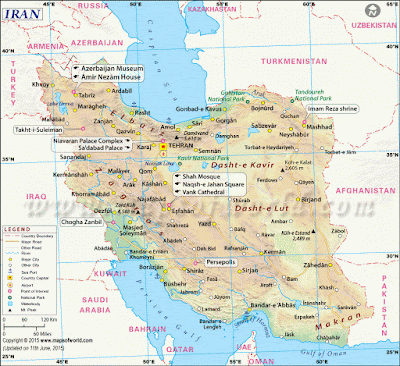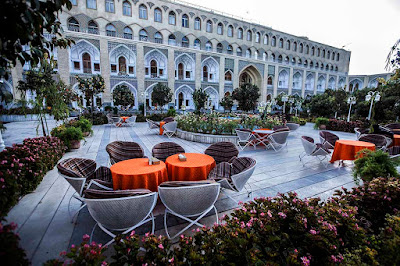While in
Yazd I wandered by a complex of shops selling pottery, brass and copper work, fabrics, clothes, carpets, and other items of interest to tourists, gadabouts, and pilgrims, both domestic and international.
Courtyard of the shopping complex (click on photos for enlargements)
Pottery for sale at the complex
I was most interested in carpets. Stepping into one store I was surprised to see a selection of carpets very much like some that I already had in my hovel in
Zaisan Tolgoi. I had bought mine in Bukhara, Uzbekistan, however. “Where are these carpets made?” I asked. I fully expected the salesmen to say “Yazd”, since most visitors are interested in buying locally made products. Instead he answered, “They are made in Serakhs.” “Serakhs, Iran, or Serakhs, Turkmenistan?” I wondered. The salesmen smiled, “Probably both.”
Salesmen in carpet store
I have of course been in Serakhs, Turkmenistan, since it was one of the cities trashed by Chingis Khan’s son Tolui in 1221. I did not have an Iranian visa at the time, so I could not visit Serakhs in Iran, which is right across the border. Nor did I have time to check out carpets stores, as my Turkmenistan visa was expiring and I had to get back to
Ashgabat.
Ruins of the ancient city of Serakhs, destroyed by Tolui. The modern city is nearby, with a sister city just across the border in Iran.
Serakhs carpets in Yazd
Serakhs carpets in Yazd
Serakhs carpets in Yazd
Serakhs carpets
Serakhs carpets in Yazd
These kinds of carpets, single knotted silk, with emphasis on the color red, are often called “
Bukhara Carpets” or “Bukharans”, after Bukhara in Uzbekistan. They were given these names because they were commonly sold in Bukhara, one of the great Silk Road emporiums, not because they were made there. Even today dealers in Bukhara will try to tell you that they are made in Bukhara, but even the most cursory investigation will prove this not to be true. The salesmen in the stores adamantly stick to this story, however. Someone else in Bukhara, a salesman in a store selling hand-woven fabrics who appeared to have a grudge against the carpets guys, warning me that they were dyed-in-the-wool liars and not to believe a word they said about anything, told me that it was common knowledge among local merchants that the carpets in question came from Serakhs, in Turkmenistan. I seem to have found proof of this assertion here in Yazd.

“Bukharan” carpets in the Abdullah Khan Tim. In all likelihood they were made in Serakhs.
“Bukharan” carpets
“Bukharan” carpets
A “Bukharan” carpet, probably made in Serakhs, on the floor of my hovel in
Zaisan Tolgoi, Mongolia.
Regardless of where they are made, they are gorgeous carpets. I showed one to some
Carpet Guys In Istanbul and they grudgingly admitted—they are not big fans of single-knot carpets—that they were of excellent quality. One dealer even offered me cash for one. The profit would have covered my plane ticket to Ashgabat, but I passed. I certainly do not want to become even a part-time carpet dealer, a profession which on the social scale is only slightly above pimps, prostitutes, bartenders, and lawyers.
























































